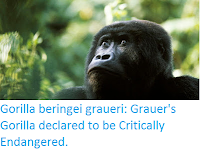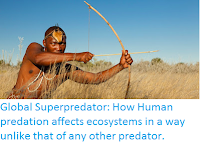African Forest Elephants (Loxodonta cyclotis) are found in undisturbed forests in Central Africa. They were not recognised to be a separate species until 2010 largely due to the remote locations where they live, and are still poorly understood by zoologists and conservationists. Generic studies have found that they are not just distinct from other African Elephants, they are more closely related to the extinct European Straight-tusked Elephant (Palaeoloxodon antiquus) than to either of their living relatives. Despite living in areas hard to reach, these Elephants are thought to be particularly vulnerable to Human activities such as hunting, largely in the form of poaching for the (illegal) ivory trade and deforestation (which fragments the large areas of forests the Elephants leave, resulting in a network of forest patches too small to use separated by unsuitable open habitats.
50% of all African Forest Elephants are thought to live within the borders of Gabon, making conservation efforts in that country crucial to the survival of the species. The Minkébé National Park in northern Gabon was created in 2002 to provide a refuge for Elephants. It covers an area of about 7570 km² (34% larger than the average size of such parks in West and Central Africa, and is isolated, being 58 km from the nearest major highway. The location was chosen as it was home to a large population of Elephants, with one of the highest population densities in Central Africa.
The park was not initially well funded, limiting the staffing and resources available to either manage the park or protect the Elephants. In 2011 concern about poaching led to the government of Gabon to raise the status of the Forest Elephant to ‘Fully Protected’ and establish a National Park Police to man the park. However this does not appear to have been sufficient to remedy the situation, with staff in the park recording 161 poached Elephant carcases between 2012 and 2015, and a significant amount of ivory seized on the international market which has been sourced to the tri-national area of Cameroon, Gabon and Congo.
In a paper published in the journal Current Biology on 20 February 2017, a team of scientist led by John Poulsen of the Nicholas School of the Environment at Duke University and the Agence Nationale des Parcs Nationaux in Gabon, describe the results of a study of the decline of the population of African Forest Elephants in the Minkébé National Park.
Poulsen et al. used data from two large scale surveys of Elephant dung in the park made in 2004 and 2014. The data obtained by these surveys was analysed using two separate analytical techniques; distance-sampling and dung-rainfall, in order to provide two separate estimates of the population in the two years. The distance-sampling method produced an estimate of 32 851 Elephants in 2004 and 7370 in 2014, a drop in population of 77.6%, while the dung-rainfall method produced an estimated population of 35 404 Elephants in 2004 and 6542 in 2014, a drop of 81.5%.
Elephant in the Minkébé National Park. Poulsen et al. (2017).
Either of these results points to a dramatic decline in Elephant numbers in the park, with poaching being the most likely source of the problem. Poulsen et al. speculate that much of the poaching in the north and central parts of the park can be attributed to organised crime syndicates operating out of Cameroon (to the north), noting that in 2011 park authorities discovered an illegal mining encampment in the centre of the park, where over 6000 migrants, principally from the town of Djoum in Cameroon, were also engaging in other illegal activities such as mining. However Gabon also appears to have its own home-grown poaching problem, with timber concessions to the west and south of the park providing logging roads that give access to the park.
Poulsen et al. observe that Elephant ivory is not currently listed on Appendix 1 of the Convention on the International Trade in Endangered Species (CITES), due to fears that some nations would pull out of the convention altogether if it were so listed. Similarly the African Forest Elephant is not currently recognised as a separate species under the terms of the International Union for the Conservation of Nature’s Red List of Threatened Species, for very much the same reasons They recommend that the African Forest Elephant should be recognised as a separate species on the Red List, and that all products derived from the species should be listed under Appendix 1 of the CITES convention.
See also...
Follow Sciency Thoughts on Facebook.







